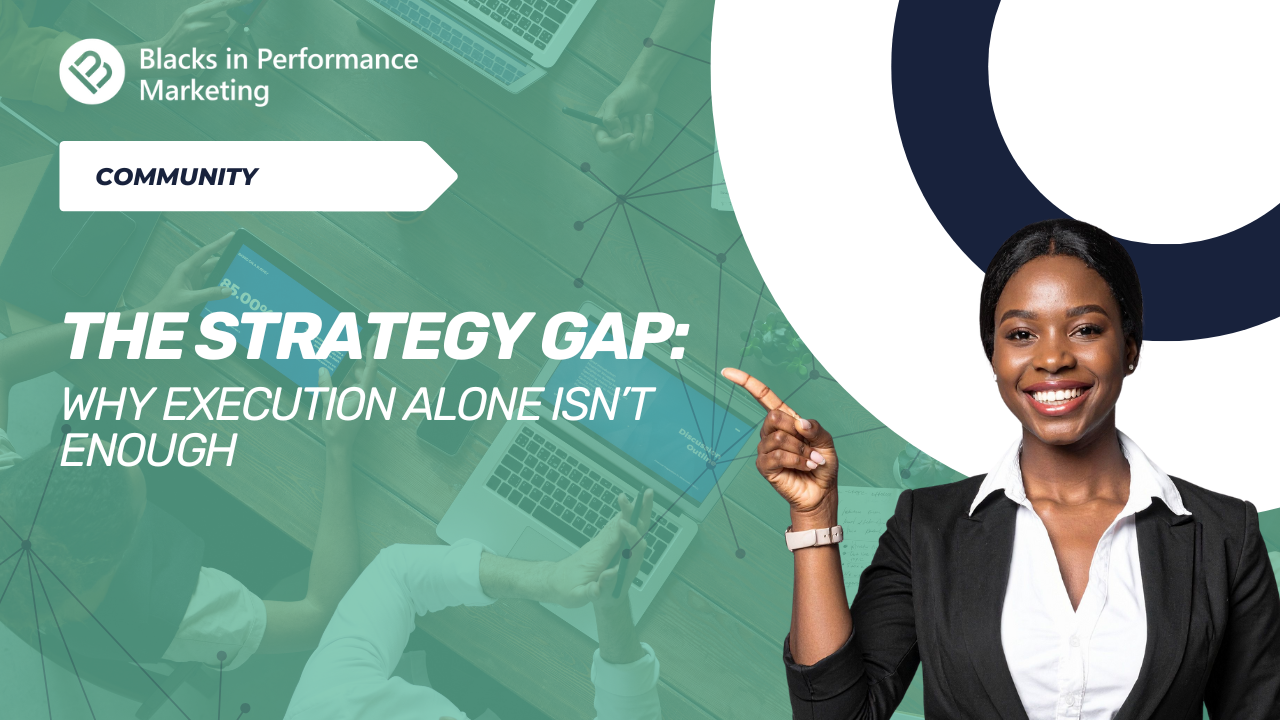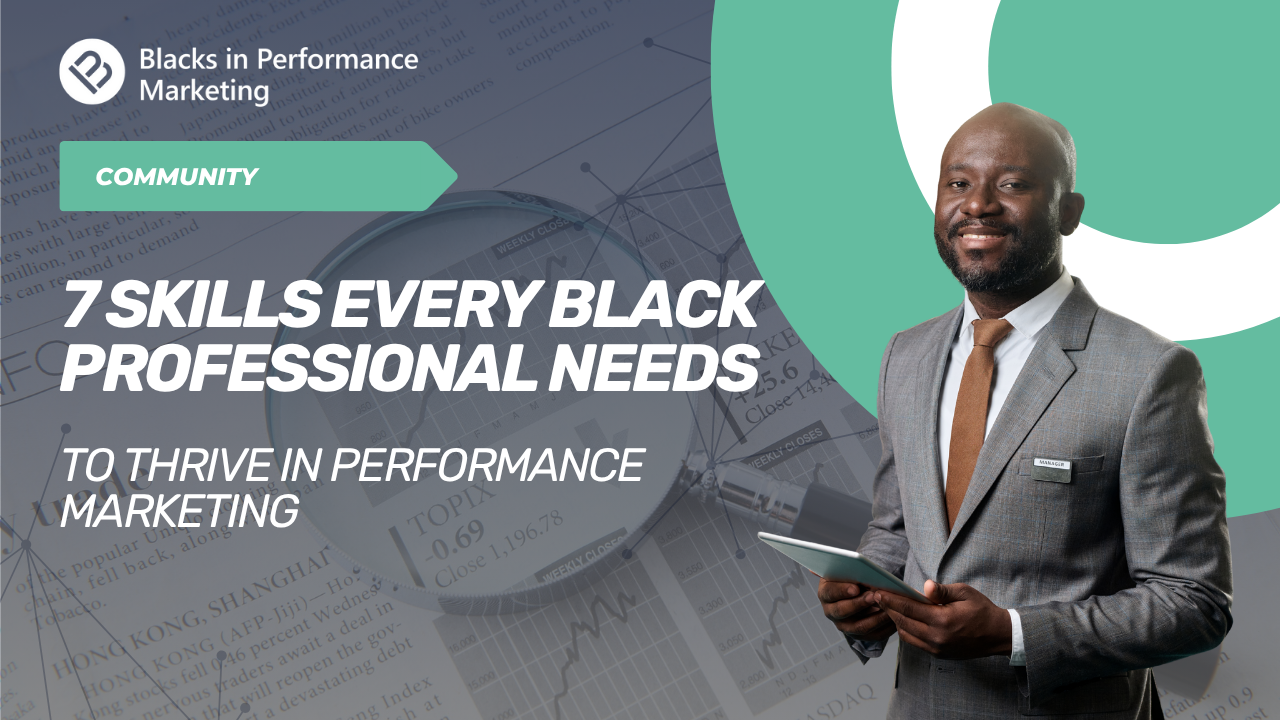Blacks in Performance Marketing
The Strategy Gap: Why Execution Alone Isn’t Enough
Introduction: The Invisible Wall Between “Doers” and “Deciders”
If you’re constantly in doing mode—cranking out campaigns, meeting deadlines, delivering high-quality work—yet still invisible when big decisions are made, you’re not alone.
You’re likely caught in what experts call the strategy gap.
It’s the silent divide between those who execute strategy and those who create it. And in marketing, where the line between creativity and leadership blurs daily, it can define the difference between being seen as essential versus being seen as replaceable.
Here’s the truth:
Brilliance in execution isn’t enough to build influence.
Strategy is the currency of leadership—and it’s time to earn it.
- Understanding the Strategy Gap
What the Strategy Gap Really Means
The strategy gap is the disconnect between what gets done and why it’s being done.
It’s when smart, capable professionals execute flawlessly—but aren’t included in defining direction.
This gap exists not because of lack of talent, but because most workplaces reward action, not thought.
The Difference Between Strategy and Execution
- Execution asks: How do we make this happen?
- Strategy asks: Why are we doing this, and what does success look like?
Execution focuses on tasks. Strategy focuses on direction.
Both are necessary—but only one determines long-term impact.
How the Gap Silently Limits Career Growth
Remaining in execution-only mode limits visibility. If your role centers on tasks rather than business outcomes, leadership sees you as support—not as a strategic partner.
Translation: less influence, slower promotions, and lower pay.
- The Psychology of the Executor Trap
Why High Performers Often Stay Invisible
Ironically, the most reliable, capable employees often fall into the executor trap. They’re the go-to people for getting things done—so leadership keeps them there.
But consistency without visibility breeds stagnation.
The Reward Bias: How Companies Value Output Over Insight
Most companies measure performance in deliverables, not ideas. This creates a reward system that prizes output—emails sent, ads launched, reports filed—over strategic contribution.
The result? Brilliant thinkers stay underrecognized.
Signs You’re Stuck in the Execution Loop
- You’re praised for efficiency, not insight.
- You deliver reports but don’t interpret them.
- You’re rarely invited to planning or strategy meetings.
- You feel your value is tied to “doing more,” not “thinking bigger.”
- Making the Mindset Shift from Executor to Strategist
Think in Outcomes, Not Tasks
Strategic thinkers don’t just finish tasks—they connect them to business outcomes.
Instead of “I managed a paid social campaign,” say,
“I optimized our paid social strategy to increase ROI by 25%.”
That shift in language reframes you as someone who drives results, not just manages processes.
Start Asking “Why” Instead of “How”
Strategists ask “why” questions:
- Why this channel?
- Why this audience?
- Why now?
Asking “why” positions you as someone who thinks about the big picture. It also earns respect—because strategy begins with curiosity.
Reframing Execution Work into Strategic Impact
Every task has strategic value—you just need to articulate it.
For example:
- Running a campaign? → You’re testing market response.
- Building a report? → You’re informing business decisions.
- Managing budgets? → You’re optimizing return on investment.
Frame your daily actions as part of a larger story.
- Framing Your Ideas for Leadership Buy-In
Speaking the Language of Business (ROI, Revenue, Results)
Leaders think in terms of numbers and impact. To be heard, you need to translate your insights into business language.
Instead of saying, “Our campaign got great engagement,” say,
“Our campaign improved conversion rates by 18%, generating an additional $40K in revenue.”
Structuring Your Ideas for Decision-Maker Impact
Use this simple formula:
Problem → Insight → Opportunity → Recommendation.
Example:
“We’ve noticed declining engagement among repeat customers (problem). The data shows a 20% drop in email open rates (insight). This suggests we need stronger personalization (opportunity). I recommend implementing audience segmentation (recommendation).”
Turning Data Into a Persuasive Narrative
Data alone doesn’t drive change—stories do. Learn to tell the story behind the numbers. Frame analytics as proof of direction, not just performance.
- Why Brilliant Marketers Stay Underpaid
Execution Is Replaceable—Strategic Thinking Isn’t
Execution can be outsourced, automated, or replicated.
But strategic thinking—connecting insights, foresight, and human understanding—is irreplaceable.
That’s why strategists earn more, get promoted faster, and have greater autonomy.
How to Quantify and Communicate Your Value
Document the outcomes of your work.
- What was the business impact?
- How did you improve efficiency or revenue?
- What decisions were shaped by your insights?
Show receipts. It turns perception into proof.
The Cost of Staying Behind the Scenes
If you don’t advocate for your ideas, someone else will—and they’ll get the credit.
Strategic silence is expensive.
Visibility isn’t vanity—it’s leverage.
- Building Strategic Visibility and Influence
Join Cross-Functional Projects and Strategy Sessions
Volunteer for initiatives that connect marketing with sales, product, or finance. Exposure to other departments helps you understand the business ecosystem—and elevates your perspective.
Present Solutions, Not Just Reports
When sharing data, pair it with insights.
Don’t just say, “Here’s what happened.”
Say, “Here’s what it means, and here’s what we should do next.”
Document and Share Wins Strategically
Use tools like Notion, Google Docs, or even LinkedIn posts to record and share your wins. Visibility isn’t bragging—it’s proof of value.
- From Doing More to Thinking Higher
Redefining Productivity as Strategic Progress
Being “busy” doesn’t mean you’re moving forward.
Shift your focus from doing more work to doing more meaningful work.
Ask: “Is this task moving the strategy forward—or just maintaining motion?”
Balancing Execution Efficiency with Strategic Intent
You’ll always have to execute—but add a layer of insight to everything you do.
That’s how you evolve from executor to strategic operator.
Becoming Indispensable as a Strategic Partner
When you bring solutions, not tasks…
When you anticipate questions before they’re asked…
When you align actions to vision—
You stop being staff, and start being strategy.
FAQs: Closing Your Strategy Gap
- How can I develop strategic thinking skills?
Read case studies, listen to CMO podcasts, and practice connecting daily work to broader business goals.
- How do I transition from executor to strategist in my role?
Start by reframing your contributions. Offer proactive insights in meetings instead of just updates.
- How can I get leadership to listen to my ideas?
Speak in outcomes—tie your ideas to metrics like revenue, retention, or growth.
- Why do strategic roles pay more than executional ones?
Because strategic thinkers create direction, not just output. They reduce risk and increase value.
- How can I demonstrate strategy in interviews or reviews?
Share specific examples of how your insights led to measurable results or process improvements.
Conclusion: Strategy Isn’t a Title—It’s a Mindset
Moving from execution to strategy doesn’t happen overnight—but it starts with a shift in thinking.
Stop waiting to be invited to the table. Start bringing insight to the table you already sit at.
Because it’s not about doing more.
It’s about thinking higher—and owning your impact.





